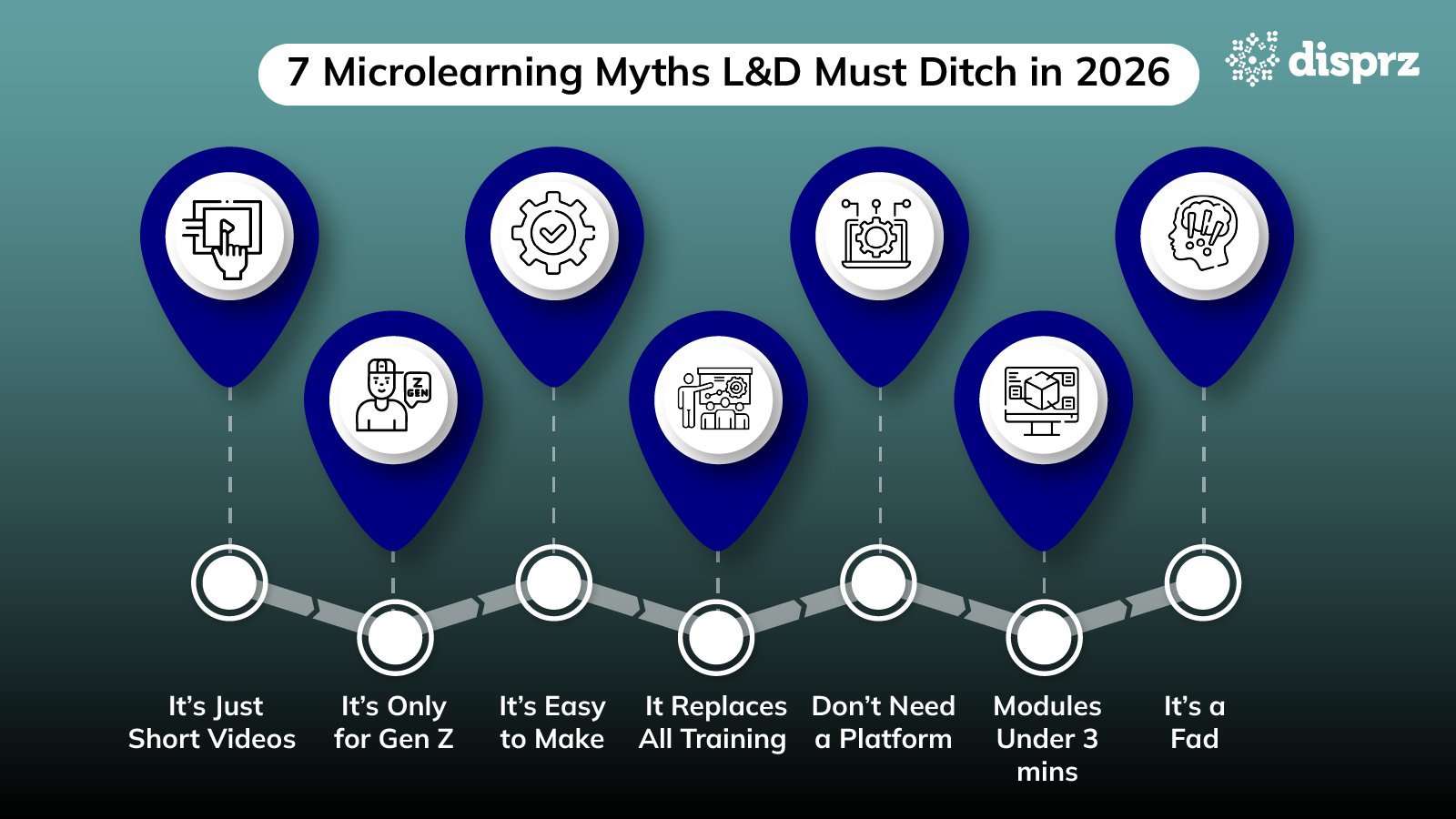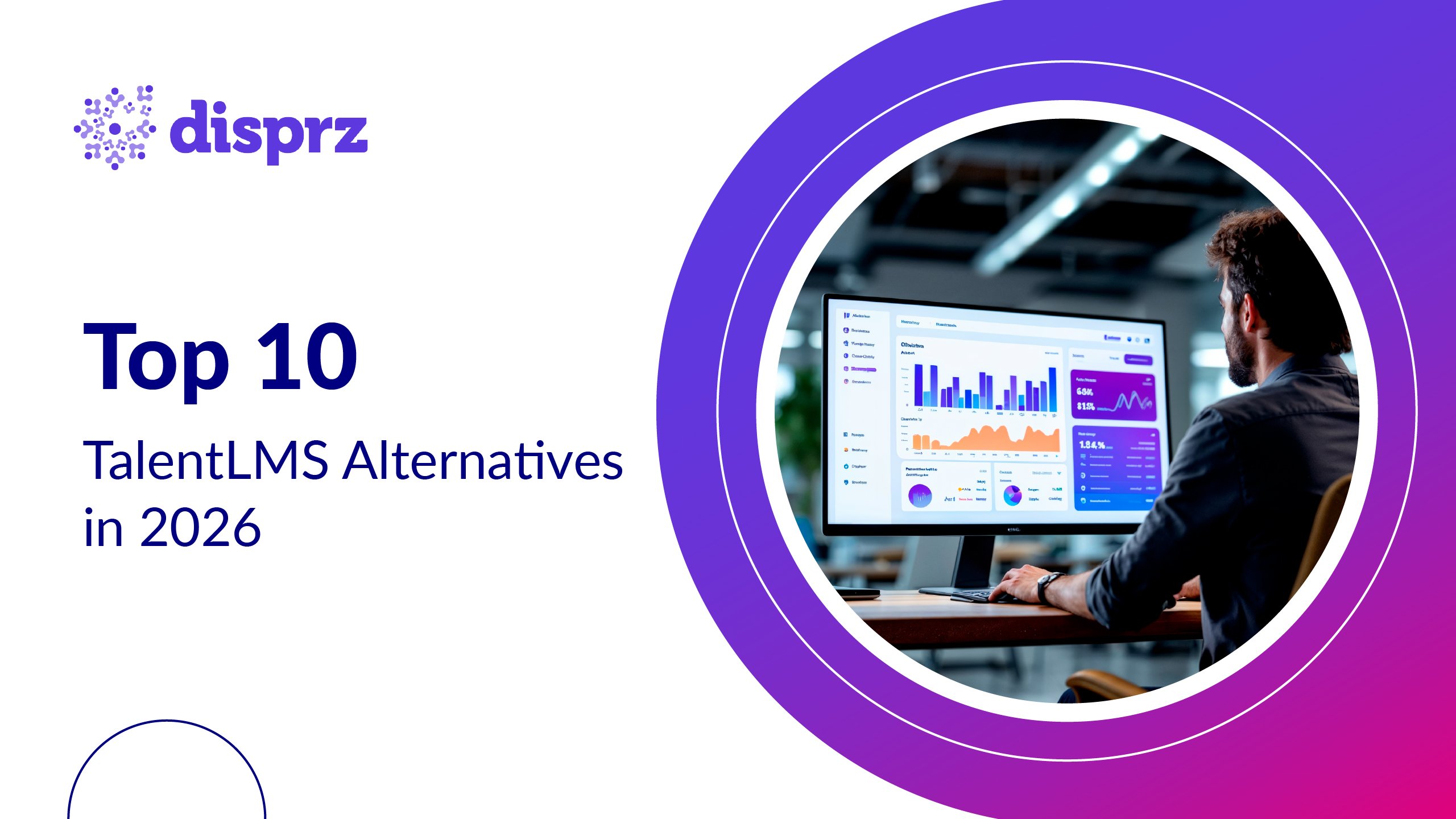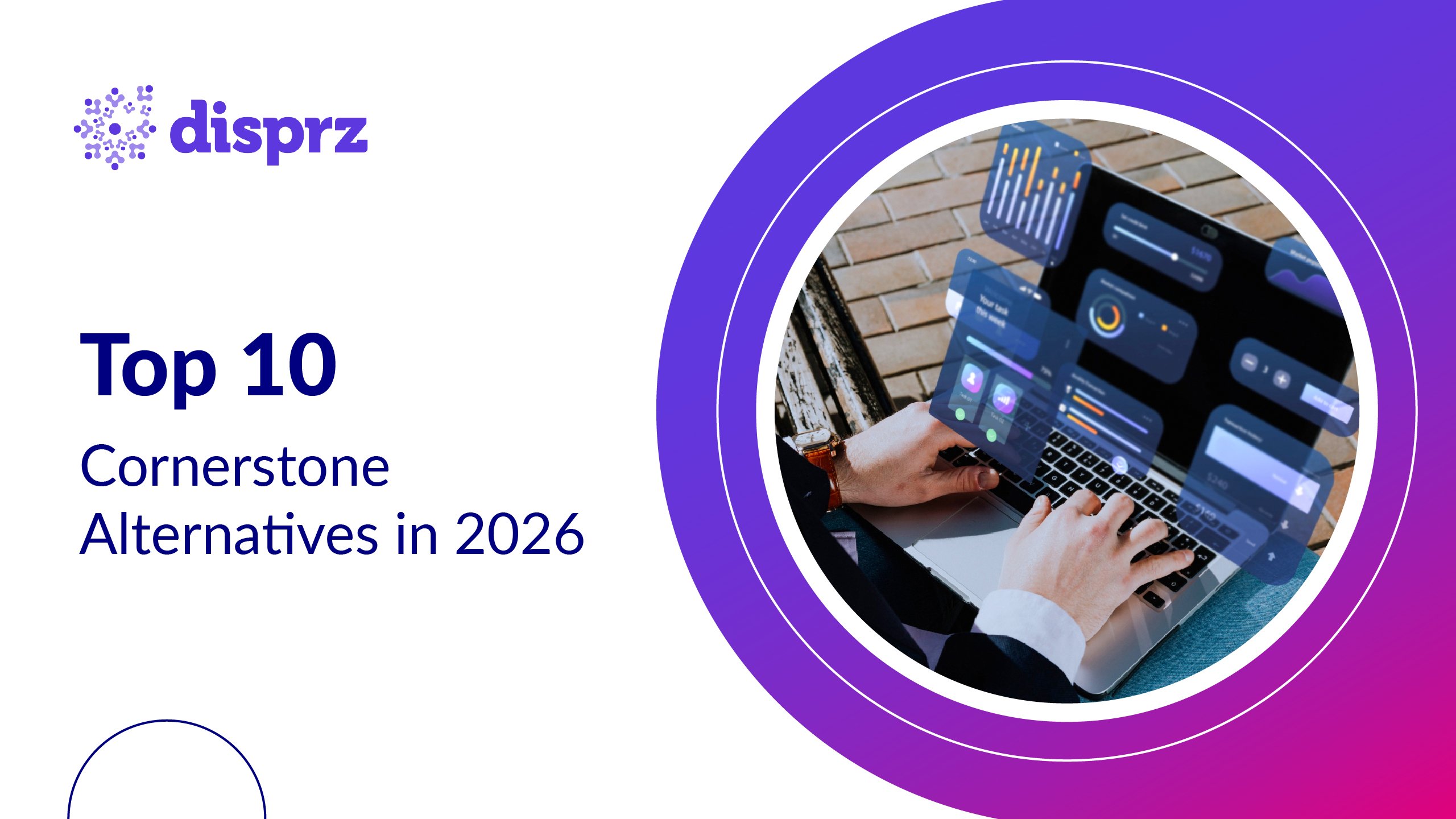In 2026, the average employee’s attention span has dropped to just 47 seconds before switching tasks (Harvard Business Review, 2025). For L&D leaders battling the forgetting curve, shrinking learner time, and content overload, this means one thing; traditional training alone won’t cut it.
Enter microlearning; the modern, flexible way to build skills faster, sustain engagement, and drive measurable business impact.
This guide covers everything you need to know: from the microlearning definition and benefits of microlearning to real-world examples, an AI-powered learning platform, and the best practices for success in corporate training. You’ll also learn how Disprz helps enterprises deliver microlearning at scale.
Microlearning breaks training into short, focused bursts; ideal for today’s distracted workforce. It boosts retention by up to 60%, drives higher completion rates, and fits seamlessly into daily workflows. This 2026 guide explores its benefits, myths, examples, and tools, plus how AI-powered microlearning enhances employee engagement and retention in modern enterprises.
What is Microlearning (and What It Isn’t)
Microlearning is a learning strategy that delivers knowledge in short, focused bursts designed to achieve one specific learning objective. It’s bite-sized, flexible, and just-in-time; making it ideal for busy, modern learners who want to learn on demand rather than in long sessions.
The 2026 Reality
According to LinkedIn Learning’s 2025 Workplace Report, 72% of organizations have now embedded microlearning in their corporate training mix; a sharp rise from 54% in 2023. Deloitte’s 2025 research also found that organizations using microlearning report 50% faster skill development compared to traditional programs.
But here’s the catch; microlearning isn’t just about short videos or snackable content. It’s structured, purposeful, and aligned to business outcomes. Each module should focus on a single concept, behavior, or skill; not random trivia or disconnected clips.
Microlearning vs eLearning vs Nanolearning
| Type | Purpose | Typical Length | Best Used For |
|---|---|---|---|
| Microlearning | Build or reinforce one skill at a time | 3–7 minutes | On-the-job learning, reinforcement, mobile delivery |
| eLearning | Deliver structured, in-depth courses | 30–60 minutes | Comprehensive training, onboarding, certifications |
| Nanolearning | Instant learning moments for micro-tasks | ≤2 minutes | Quick answers, reminders, contextual nudges |
Key takeaway: Microlearning is not random short content. It’s strategically designed to solve a defined learning need, delivered through the right channel, and tracked for performance impact.
Benefits of Microlearning in 2026 (Backed by Data)
Modern employees crave learning that fits into their flow of work; not another long, static course. In 2026, microlearning in corporate training is no longer a trend but a core strategy to boost engagement, retention, and ROI.
Below are the top 7 data-backed benefits every L&D leader should know.
1) Higher Knowledge Retention
-
Learners retain 25–60% more information through microlearning than traditional methods (LinkedIn Learning, 2025).
-
Breaking content into short, spaced modules helps fight the forgetting curve.
-
AI-powered microlearning ensures content is revisited at the right time through smart nudges.
2) Better Course Completion Rates
-
Micro-courses see 80–90% completion rates, compared to ~30% for long-form eLearning (SHRM, 2025).
-
Mobile-friendly design allows learners to finish training during commutes or breaks.
-
AI-driven reminders and gamified challenges boost consistency.
3) Faster Development & Deployment
-
Microlearning takes 40–60% less time to create than traditional courses (Deloitte, 2025).
-
Modular content allows agile updates as priorities shift.
-
AI video and text tools speed up content creation and localization.
4) Stronger Learner Engagement
-
Short, goal-driven modules match modern attention spans.
-
Personalized, mobile-first delivery keeps engagement rates 35% higher (Learning Guild, 2025).
-
Real-time analytics help L&D teams adapt topics to learner interests.
5) Improved ROI & Business Impact
-
Organizations using microlearning report 31% higher ROI on training investments (LinkedIn Learning, 2025).
-
Measurable impact is easier when each module is tied to a single skill or KPI.
-
AI analytics help map learning outcomes to performance gains.
6) Continuous Learning Culture
-
Frequent micro-sessions encourage “learning in the moment.”
-
Employees access content anytime, anywhere via mobile or QR codes.
-
Smart nudges and peer-sharing features sustain momentum.
7) Greater Flexibility for Diverse Teams
-
Global, multilingual workforces thrive on short, modular learning.
-
Content can be localized, translated, or replaced quickly.
-
AI-powered translation and accessibility features make learning inclusive for all.
In short: Microlearning delivers speed, scalability, and measurable performance; all while keeping employees engaged. In 2026, L&D leaders will use it not just to train but to transform workforce capability.
7 Microlearning Myths L&D Should Stop Believing in 2026
Even as microlearning in corporate training becomes mainstream, myths still cloud how L&D teams design and measure it. Let’s clear them up with data and reality.

MYTH 1. “It’s Just Short Videos”
Not true. Microlearning is about achieving one learning objective, not just creating short clips. A 2025 Axonify study found that structured micro-modules outperform random short content by 42% in knowledge retention. Think purpose, not duration.
MYTH 2. “It’s Only for Gen Z”
Wrong again. Microlearning appeals across generations because it respects time. Deloitte’s 2025 Workforce Learning Report shows that 64% of Gen X and Baby Boomers prefer mobile microlearning for flexibility. Everyone wants efficient, on-demand training; not just digital natives.
MYTH 3. “It’s Easy to Make”
Quick to consume is not the same as quick to design. Quality microlearning requires clear objectives, strong visuals, and interactive elements. According to the Learning Guild (2025), poorly designed short content leads to 35% lower engagement. Thoughtful instructional design still matters.
MYTH 4. “It Replaces All Training”
Microlearning complements, not replaces, deep learning. It’s perfect for reinforcement, refreshers, and performance support. Strategic L&D leaders use it alongside longer eLearning, coaching, or classroom programs to create blended learning ecosystems.
MYTH 5. “You Don’t Need a Platform”
Microlearning without the right tech equals chaos. Delivery platforms with AI recommendations, analytics, and nudges are critical to scale. 2025 LinkedIn data shows that organizations using LXPs or AI-driven LMSs achieve 2.3x higher engagement than those relying on manual delivery.
MYTH 6. “All Modules Must Be Under 3 Minutes”
Length should serve the learning goal, not a fixed rule. Some concepts need five or even seven minutes. The key is focus and value per minute. Learners complete modules when the outcome is clear, not just because they’re short.
MYTH 7. “It’s a Fad”
Microlearning has evolved from buzzwords to proven strategies. Global adoption rose 34% year-on-year (2025, Training Industry Report), with enterprises tying it directly to performance metrics. With AI personalization, microlearning is now the engine of continuous learning, not a passing trend.
Bottom line: Microlearning in 2026 is strategic, data-driven, and AI-enhanced; not an experiment. Smart L&D leaders treat it as a performance tool, not a content shortcut.
Microlearning Examples that Actually Drive Performance
The best way to understand microlearning is to see how it’s applied in real business scenarios. When done right, microlearning connects learning to on-the-job performance; not just completion badges.
Below are examples of formats and use cases that drive measurable results in 2026.
Common Microlearning Formats
| Format | Description | Ideal For |
|---|---|---|
| Short Videos | Bite-sized explainers or demos focused on one concept | Product training, onboarding |
| Flashcards | Quick recall aids for facts, steps, or policies | Compliance, sales cues |
| Micro-Courses | 3–5 short modules built around a single topic | Skill reinforcement, role-based training |
| Interactive Quizzes | Gamified assessments for spaced learning | Engagement and retention tracking |
Real-World Use Cases by Function
| Function | Example | Time to Complete | Learning Goal |
|---|---|---|---|
| Sales Enablement | 3-minute “Handling Objections” video series delivered via mobile push | 3 min per module | Improve confidence and close rates through scenario-based learning |
| Compliance Training | Daily 1-question refresher quiz (AI-randomized) | 1 min per day | Reinforce policy awareness and reduce non-compliance incidents |
| Frontline Teams | QR-code “Shift Start Cards” with micro-tips on safety or product updates | 2 min per shift | Deliver real-time knowledge at point of need |
| Leadership Development | Weekly 5-minute reflection podcast + journaling prompt | 5–7 min | Build self-awareness and strengthen coaching culture |
Each of these examples is structured around one outcome, delivered in the learner’s workflow, and supported by analytics. The key is to connect learning content to daily performance behaviors, not just knowledge checks.
AI-powered microlearning platforms such as Disprz now help automate delivery timing, personalize sequences, and measure skill application in real time.
Common Challenges (and How to Solve Them)
Even with its growing popularity, microlearning in corporate training comes with real-world hurdles. The good news? Each challenge has a clear, actionable fix.
@2x-100.jpg?width=1622&height=915&name=Common%20Microlearning%20Challenges%20(and%20Fixes)@2x-100.jpg)
1) Maintaining Content Relevance
Micro modules can age quickly; outdated examples or visuals reduce credibility.
Solution: Set quarterly content audits and retire or refresh modules using analytics on engagement and completion trends.
2) Scaling Personalization
Learners expect content tailored to their roles, not a one-size-fits-all library.
Solution: Use AI-powered microlearning to recommend modules based on role, skills gap, and learning behavior.
3) Accessibility for All
If your learning isn’t accessible, adoption will drop.
Solution: Ensure captions, color contrast, multilingual options, and offline access across all microlearning content.
4) Time Constraints
Employees struggle to dedicate even 10 minutes to learning.
Solution: Embed microlearning into daily workflows; link modules to real tasks, tools, or communication channels (such as Slack or MS Teams).
5) Content Governance & Version Control (New in 2026)
Micro content multiplies fast, creating chaos without governance.
Solution: Create a content ownership matrix and review cycles; tag modules by topic, owner, and expiry date.
6) Analytics & ROI Tracking (New in 2026)
Few teams can clearly show the business impact of microlearning.
Solution: Tie learning KPIs (such as completion, retention, and skill uplift) to performance metrics; e.g., productivity or sales growth.
Takeaway: The most successful L&D teams treat microlearning like a living system; one that evolves, measures itself, and continuously aligns to business goals.
The Microlearning Playbook (Step-by-Step)
Building a high-impact microlearning program in 2026 requires more than just creating bite-sized videos. You need structure, analytics, and agility.
Here’s your 5-step playbook to do it right.
Step 1: Plan: Define the “Why” and “Who”
-
Start with a single learning objective and a clear target audience.
-
Identify what problem you’re solving; skill gap, behavior change, or performance enablement.
-
Pro Tip: Keep each microlearning module focused on one actionable takeaway.
Step 2: Produce: Design for Focus and Flow
-
Choose the best format (video, podcast, card, or quiz) based on the learning goal.
-
Use visuals, audio, and interactivity to boost recall.
-
Pro Tip: Keep modules under 7 minutes, script tightly, and use AI video or interactive design tools for faster production.
Step 3: Deliver: Reach Learners Where They Are
-
Host your microlearning on an LMS or LXP that supports mobile delivery, AI nudges, and multilingual support.
-
Push content through the channels learners already use (Slack, Teams, WhatsApp).
-
Pro Tip: Use push notifications and spaced reminders to reinforce learning habits.
Step 4: Measure: Track What Truly Matters
-
Don’t just track completion. Measure application, engagement, and performance impact.
-
Link analytics to business KPIs such as sales conversion, productivity, or compliance rates.
-
Pro Tip: Use micro-analytics dashboards to see which modules drive real-world outcomes.
Step 5: Iterate: Refresh, Reward, and Reinforce
-
Review analytics quarterly to refresh outdated modules or retire low-performing ones.
-
Encourage learners or internal SMEs to co-create content.
-
Pro Tip: Incentivize creators; recognition programs can increase internal content generation by up to 40% (Deloitte, 2025).
Summary: A strong microlearning playbook isn’t just about shorter content; it’s about precision, personalization, and continuous improvement.
The Tools & Platform Checklist
Choosing the right platform is key to delivering microlearning at scale. In 2026, the best systems don’t just host content; they personalize, measure, and automate every part of the learning journey.
Here’s a quick checklist of must-have capabilities for L&D leaders evaluating a platform:
| Feature | Why It Matters |
|---|---|
| Mobile-First UX | Learners engage most during “in-between moments”; a mobile-friendly interface drives 2x higher completion rates. |
| AI-Powered Personalization | Recommends the right microlearning modules based on skills, roles, and engagement history. |
| Micro-Analytics Dashboard | Tracks performance at the module level (completions, retention, quiz scores, and time spent). |
| Learning Nudges & Notifications | AI-triggered reminders sustain learning momentum and reduce drop-offs. |
| Multilingual & Localization Support | Enables global rollout with localized content and interface options. |
| SSO & Integrations | Seamlessly connects with HRMS, MS Teams, Slack, or CRM systems for in-workflow learning. |
| Skills Mapping & Analytics | Links microlearning modules directly to organizational skill frameworks and proficiency levels. |
| Creator Tools / AI Content Assistants | Allow quick creation of videos, cards, and quizzes by internal teams; no design expertise needed. |
Tip: Before finalizing a platform, test its AI recommendation engine and analytics depth; these determine whether your microlearning program scales with measurable business impact.
How Disprz Powers Microlearning at Scale
At Disprz, we believe microlearning is the foundation of continuous skill growth; not just a training tactic. Our AI-powered learning platform enables organizations to design, deliver, and measure bite-sized learning journeys that drive real business outcomes.
Disprz brings together content automation, personalization, and performance analytics to make learning seamless for every employee; from frontline workers to leaders.
What Sets Disprz Apart in 2026
-
AI-Powered Recommendations: Suggests the right microlearning modules based on role, skill gap, and learning behavior.
-
Skills Analytics: Tracks proficiency growth and links microlearning to measurable business KPIs.
-
Manager Dashboards: Provide real-time visibility into team progress and engagement metrics.
-
Mobile-First & Multilingual: Learning accessible anywhere, in local languages, with offline support.
-
Automation at Scale: Automatically curates, updates, and retires micro-content using performance data.
Real-World Impact
A leading UAE retail brand used Disprz to deliver daily microlearning to over 5,000 store employees. Within three months, the organization saw:
-
62% increase in compliance quiz completion rates
-
4.5x boost in product knowledge scores
-
Significant drop in customer complaint escalations
By combining AI recommendations with mobile delivery and skill analytics, Disprz helped transform learning from an event into a daily performance enabler.
Ready for microlearning as your competitive edge? Explore how Disprz can help your enterprise build a smarter, skill-first workforce. Book a demo.
Key Takeaways
-
Microlearning is now mainstream (2026): Over 70% of organizations use it to deliver agile, on-demand corporate training.
-
Short is not random: True microlearning is structured, outcome-driven, and aligned to business KPIs; not just bite-sized content.
-
AI-powered microlearning personalizes delivery, boosts completion, and predicts performance impact through analytics.
-
Data proves its power: Retention improves up to 60%, and course completion rates exceed 80% when learning is modular and mobile-first.
-
Best practices matter: Focus on one learning goal, measure outcomes, and refresh content regularly Platforms such as Disprz help enterprises scale microlearning through skills analytics, automation, and multilingual delivery; driving real employee engagement and retention.
Conclusion: Make Learning Continuous, Not Occasional
In 2026, the most successful organizations are those that embed learning into everyday work. Microlearning makes this shift possible; turning training from an occasional event into a continuous growth experience.
AI-powered microlearning isn’t just about efficiency; it’s about building agile, self-driven learners who can keep pace with evolving business needs. The future of learning lies in short, smart, and measurable moments that build long-term capability.
Ready to transform how your workforce learns? Empower your teams with Disprz, the modern learning platform that combines AI personalization, skills analytics, and microlearning automation to drive continuous performance improvement. Book a demo.
Frequently Asked Questions (FAQs)
1) What’s the ideal length of a microlearning module?
There’s no universal rule, but most effective modules last 3 to 7 minutes. The focus should be on one learning objective; whether it’s mastering a skill, reinforcing knowledge, or solving a specific problem. Shorter formats (under 2 minutes) work well for quick refreshers or task-based tips. The goal isn’t brevity for its own sake; it’s clarity and impact per minute.
2) Can microlearning replace traditional training?
Not entirely. Microlearning complements, rather than replaces, in-depth learning. It’s best used for reinforcement, upskilling, and just-in-time learning, while traditional training works for complex topics requiring deeper exploration. The most effective L&D strategies blend both; combining microlearning for agility with formal training for depth.
3) How do we measure the ROI of microlearning?
Start with metrics beyond completion rates. Track knowledge retention, skill proficiency growth, and on-the-job performance improvements. AI-powered analytics now help connect microlearning outcomes directly to KPIs such as sales conversions or customer satisfaction. Organizations using this approach have reported 31% higher ROI on learning investments (LinkedIn Learning, 2025).
4) What’s the difference between microlearning and nanolearning?
Microlearning focuses on one topic or skill per module (typically 3–7 minutes). Nanolearning is even smaller; ultra-brief content under 2 minutes, designed for quick reminders or single-task guidance. Both are effective, but microlearning offers deeper engagement and tracking, making it better suited for structured skill development.
5) Which platform is best for enterprise microlearning?
The best platforms combine AI-powered personalization, mobile delivery, and skills analytics; enabling scale and measurable business impact. Disprz, for example, supports multilingual delivery, performance dashboards, and automated nudges, helping enterprises build microlearning ecosystems aligned to role-based skills and business outcomes.








